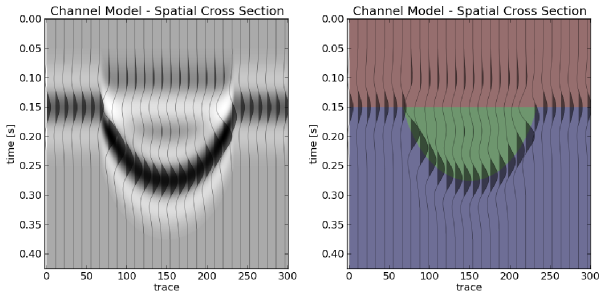Another Friday is upon us. Here is a list of items of geo-interest from the past week:
First and foremost, the Agile trio have introduced Modelr, a web-based 2D seismic forward modeling app that outputs a wedge/geometry and related seismic response, gathers and stochastic and deterministic AVO and intercept-gradient crossplots given a rock sandwich, wavelet and a few other parameters. The free version of Modelr allows the user to plot most of the above for a simple wedge using a standard suite of rock types. If you want to introduce your own rocks and use them in different geometries, like a channel (see image above) or dipping wedge, or have stochastic fun, it’s a meager $9 per month. While I have access to RokDoc 2D, I’ve signed up for Modelr because it:
a) requires minimal setup for quick testing of simple scenarios,
b) accepts not only rock data (fluids and anisotropy coming soon) but also modeling scripts that you are willing to add to the lineup (Modelr itself is open source),
c) stresses the capture and visualization of uncertainty starting at the seismic-response level,
d) has the potential to become a 3D forward modeling tool with which to close the loop between the static reservoir model and seismic,
e) works on my iPad and phone, and
f) is an Agile product and I’d be stupid not to help poke at and break cool open tools to make them better.
***
You may know that I love and often work to electronic music. Geophysical data and electronic music have a lot in common – they’re both a result of digital signal processing and it’s amazing what can be done to sound in the time and frequency domains. One of the first pieces of electronica I heard was Timesteps by Wendy Carlos, so it is nice that this second list of women who paved the way for electronic music begins with her. Don’t neglect Part 1 which starts with Delia Derbyshire, best known for creating the Doctor Who theme music, and ends with the amazing Laurie Anderson.
Dave Guarino reminds us of the real problem with open data: extract-transform-load. In other words, “taking the disparate data sets living in a variety of locations and formats (SQL Server databases, exports from ancient ERP systems, Excel spreadsheets on people’s desktops) and getting them into a place and shape where they’re actually usable.” While opening up data is critical, the data itself tells us nothing, especially when stored in myriad formats across various systems. So, more than Code and Data for America, “let’s ETL for America.” And then comes the analysis.
Interested in an Earth Science forum on Stack Exchange? Say YES here.
How Academics Learn To Write Badly. I’m not a book-burner, but there are geophysics papers I’ve come across recently that would make great kindling. How purposefully opaque and disrespectful with “their tendency to banish actual people from their writing.” Simply publishing a paper is not sharing.
After St. Patrick’s Day, keep in mind that water in REAL Guinness is sourced from the Wicklow mountains outside Dublin
Looking forward to homemade gumbo and Cosmos Episode 3 this weekend.






